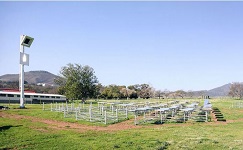South African research team develops concentrated solar power system
26 August 2015
It has been predicted that concentrated solar power (CSP) will be the key to
making solar energy a viable energy source over the next 30 years. The quest to
harness an effective and operational system has preoccupied some the best science
and technology minds in the world, including the Google RE
The challenge with CSP systems is that they require large mirrors, called
heliostats, across a large area to generate enough energy to make the technology
feasible and cost-effective. Mirrors track the sun's movement throughout the day
and reflect its energy to the top of a generator tower, where the heat is transferred
to moving water that can create electricity.
At Ivanpah, 143 000 heliostats across 1 420 hectares centralise the energy
gathered on to three central solar power generators. The plant's capacity factor –
its
ratio of actual output over time – is 31%, meaning for every hour it operates,
the plant can generate 18.6 minutes of energy. Naturally, the technology is inhibited
by its size and cost, so any way to cut these down is greatly anticipated.
South African solar energy researchers at Stellenbosch University have
designed and developed the Helio100 system, which deals with the size issue. It is
portable and easy to install without losing the technology's effectiveness: Helio100
has only 100 heliostat panels, but can generate 150kW of energy collectively,
enough to power a small suburb. At the moment, the system is aimed at relieving
the effects of load shedding, but once fully developed, Helio100 will be a viable
alternative power source.
Paul Gauché, a former strategic planner at Intel, is the founding director of the
university's Solar Thermal Research Group that developed Helio100. He explains
that the system is remarkable in its portability, referring to
what he calls "plonkable
heliostats… (meaning) that, from factory to installation, you can just drop them
down on to the ground and they work". There is no major construction involved and
minimum effort to install. "Every part in it is manufacturable (sic) and installable by
two sets of hands," Gauché told Britain's The Guardian newspaper
earlier this month.
Athi Ntisana, a technologist on the team tasked with conceptualising,
prototyping and building the finished systems, is convinced the technology is right
for South Africa. Helio100 "requires (local) labour, components manufactured here
in the country and we have land here where sunlight is abundant – and that's also
where there is not much employment. It solves all these problems."
The Helio100 system is expected to be fully functional by the end of October,
and Gauché predicts that once the technology is perfected, economies of scale will
follow to possibly create the first affordable,
small-scale, consumer-friendly CSP
system.
Source: The
Guardian
 Designed and developed at Stellenbosch University, the Helio100 system is portable and easy to install without losing the effectiveness of solar energy technology. The system can generate up to 150kW. (Image: Solar Thermal Energy Research Group)
Designed and developed at Stellenbosch University, the Helio100 system is portable and easy to install without losing the effectiveness of solar energy technology. The system can generate up to 150kW. (Image: Solar Thermal Energy Research Group)




